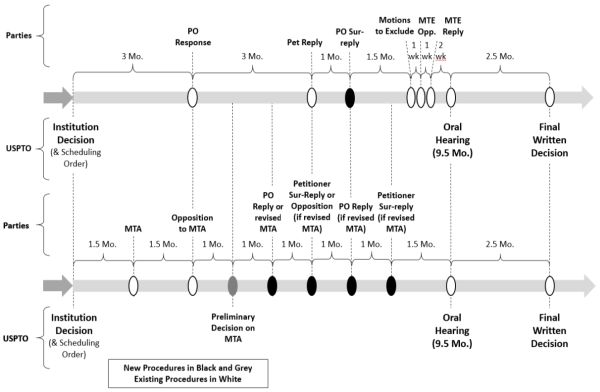A longstanding complaint of patent owners involved in inter partes review (IPR) before the United States Patent and Trademark Office (USPTO) has been the practical inability to amend the claims of a patent involved in IPR. The limited availability of amendment has largely been premised on the lack of an examination during an IPR, as compared to reexamination proceedings. As the USPTO has said, an IPR is "more adjudicatory than examinational, in nature."1 Recently, however, patent owners have seen a shift in their direction. Last year, the Federal Circuit recognized that "[d]espite repeated recognition of the importance of the patent owner's right to amend during IPR proceedings—by Congress, courts, and the PTO alike—patent owners have been prevented from amending claims in the context of IPRs."2 Last week, in remarks to the American Intellectual Property Law Association, Andrei Iancu, the director of the USPTO, announced proposed rule changes to introduce a "robust new amendment process."3 Director Iancu noted that "the AIA statute specifically provides for claim amendments" and that the newly proposed rules are intended to "make this amendment process feasible and meaningful."4 The proposed rules are set out in a Request for Comment, published in the Federal Register on October 29, 2018, which states that the "goal of the proposed amendment process and pilot program is to provide an improved amendment practice in USPTO trials in a manner that is fair and balanced for all parties and stakeholders."5
The proposed rules establish a procedural framework for a patent owner in an AIA trial proceeding (typically an IPR) to propose substitute claims in response to an institution decision, allow the petitioner to oppose the proposed amendments and have the USPTO's Patent Trial and Appeal Board (Board) issue a preliminary, nonbinding decision on the patentability of the proposed substitute claims. The proposed rules also allow the parties to respond to the Board's preliminary decision. For example, if the preliminary decision is unfavorable to the patent owner and the motion to amend is likely going to be denied by the Board, i.e., the proposed substitute claims are not considered patentable, the patent owner may file a revision to its motion to amend. This can include changes to the proposed substitute claims and further arguments for patentability to address issues presented in the preliminary decision. The petitioner would then have an opportunity to file an opposition to the revised motion to amend. The proposed rules further anticipate that the patent owner would have leave to file a reply and the petitioner a sur-reply prior to the oral hearing.
If the preliminary decision indicates that the Board is reasonably likely to grant the motion to amend, i.e., the proposed substitute claims meet the statutory requirements for patentability and the petitioner has not demonstrated a reasonable likelihood that it will prevail in establishing unpatentability of the proposed substitute claims, the petitioner may file a reply to the preliminary decision, and the patent owner may then provide a sur-reply. In this case, the petitioner's reply may include new evidence in response to new issues raised in the preliminary decision, but may not raise new arguments of unpatentability not presented in its opposition to the motion to amend. The patent owner sur-reply may not present new evidence other than deposition transcripts of any cross examination of reply witness(es).
In the event that the petitioner ceases to participate in the AIA trial but the Board still elects to proceed to a final written decision, the Board may, in its discretion, enlist the assistance of a patent examiner from the Central Reexamination Unit. In this case, the examiner would provide a nonbinding advisory report evaluating the patentability of the proposed substitute claims. If the Board enlists an examiner's assistance after the preliminary decision and after the patent owner has filed a revised motion to amend, the patent owner will be given leave to file a reply in response to the examiner's advisory report.
Under the proposed rule changes, the briefing described above should be completed within the 12-month statutory framework for completing an IPR. As illustrated in the timeline provided in the Request for Comments, the proposed procedure for motions to amend will take place in parallel with the main IPR proceedings on the original claims.

The additional rounds of briefing set out in the proposed rules follow an aggressive schedule that may place burdens on the parties and the Board alike. For example, a patent owner wishing to amend one or more claims must file a motion to amend within six weeks of an institution decision. Six weeks after the motion is filed, the petitioner must file its opposition to the motion to amend while, at the same time, the patent owner's response to the institution decision with respect to the original claims is also due. Within a month of the petitioner's opposition, the Board will issue its preliminary decision on the motion to amend. A month after the Board's preliminary decision, the petitioner's reply or patent owner's revised motion to amend is due (depending on the outcome of the preliminary decision). One month later, the petitioner's reply with respect to the original claims is due as is its opposition to the patent owner's revised motion to amend. Clearly, this procedure will add to the cost and complexity of IPRs in which the patent owner seeks to amend one or more claims.
The comment period for the proposed rules ends on December 14, 2018, and the Office intends to begin a one-year pilot program implementing the rules shortly thereafter. Although labeled a "pilot program," the newly described procedure is expected to be applied in every AIA trial instituted after the implementation date of the pilot program in which a motion to amend is filed by the patent owner.
The proposed rules may be fine-tuned by the USPTO based on received comments over the next six weeks. It appears, however, that the pilot program will be implemented shortly after the comment period ends on December 14, 2018, and largely along the lines outlined above. Once implemented, these proposed rules will impact both patent owners and petitioners. For a patent owner facing well-founded arguments against the patentability of its issued claims, the rules provide a procedural mechanism so that "appropriately-scoped claims can be drafted in light of the prior art and arguments presented," if possible.6 For petitioners, the outcomes of IPRs may be more difficult to predict since the subject claims may become moving targets. Moreover, the added complexity will likely mean additional cost (to both parties) in those cases where a patent owner elects to file a motion to amend. Of course, claim amendments have consequences, including narrowed claims that may no longer support infringement claims, a potential loss of past damages, potential intervening rights, file wrapper estoppel, etc. Thus, even with the changes likely making amendment practice more accessible to patent owners, IPRs are expected to remain a powerful tool for parties accused of patent infringement.
Footnotes
1. Idle Free Sys., Inc. v. Bergstrom, Inc., Case No. IPR2012-00027, Paper 26 at 6 (P.T.A.B. June 11, 2013) (citing Abbott Labs v. Cordis Corp., 710 F.3d 1318, 1326 (Fed. Cir. 2013)).
2. Aqua Products Products, Inc. v. Matal, 872 F.3d 1290, 1299(Fed. Cir. 2017) en banc.
4. Id.
5. Federalregister.gov/d/2018-23187 October 29, 2018. Docket No. PTO-P-2018-0062
The content of this article is intended to provide a general guide to the subject matter. Specialist advice should be sought about your specific circumstances.



